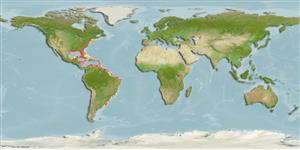Classification / Names
Common names from other countries
Main reference
Size / Weight / Age
Max length : 15.3 cm TL male/unsexed; (Ref. 37032); common length : 11.0 cm TL male/unsexed; (Ref. 5217)
Environment
Marine; brackish; pelagic-neritic; depth range 1 - 70 m (Ref. 189)
Climate / Range
Subtropical, preferred 23°C (Ref. 107945); 44°N - 36°S, 98°W - 32°W (Ref. 189)
Distribution
Western Atlantic: Massachusetts, USA perhaps occasionally straying north to Maine or even Nova Scotia (Canada), south to Fort Pierce, Florida (but not Florida Keys) and at least northern Gulf of Mexico; also from Gulf of Venezuela south to Uruguay. Replaced by Anchoa colonensis in the West Indies.
Countries | FAO areas | Ecosystems | Occurrences | Introductions
Short description
Dorsal
spines
(total): 0;
Dorsal
soft rays
(total): 14-17;
Anal
spines: 0;
Anal
soft rays: 20 - 24. Snout pointed, about 3/4 eye diameter; maxilla long, tips pointed, reaching beyond hind border of pre-operculum, almost to gill opening; gill cover canals of panamensis-type. Anal fin origin below about midpoint of dorsal fin base. Anus nearer to anal fin origin than to pelvic fin tips. Silver stripe along flank (a dark line above) of uniform width, narrowed immediately behind band (Ref. 189). Back greenish, some yellowish on head. Melanophores outline all dorsal scales (Ref. 7251).
IUCN Red List Status (Ref. 115185)
Threat to humans
Harmless
Human uses
Fisheries: minor commercial; bait: usually
Tools
Special reports
Download XML
Internet sources
Estimates of some properties based on models
Phylogenetic diversity index
PD50 = 0.5000 many relatives (e.g. carps) 0.5 - 2.0 few relatives (e.g. lungfishes)
Trophic Level
3.3 ±0.0 se; Based on diet studies.
Resilience
High, minimum population doubling time less than 15 months (tm=1; Fec=5700)
Vulnerability
Low vulnerability (16 of 100)
Price category
